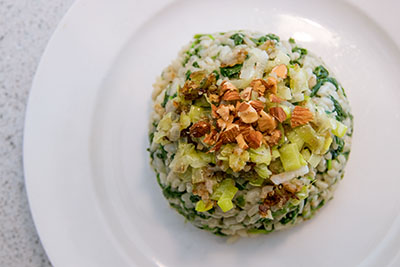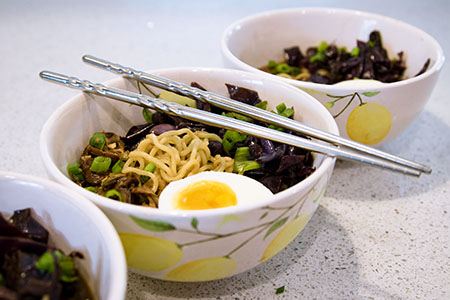Children all hear their parents complain about having to make dinner — the laborious chore seems to be universally reviled by hard-working parents tired after a long day’s work. This is where ingredient-delivery services like Blue Apron come in. The company, designed to expedite the home meal process by shipping customers recipe cards and pre-portioned ingredients, aims to make cooking hassle-free, all the while providing organic, non-GMO ingredients. To see whether the weekly subscription service lives up to the hype, Verde decided to order and cook one of Blue Apron’s three-meal packages.
The box arrived on time, with insulated packaging and ice to keep the ingredients fresh. The ingredients were neatly divided into clearly labeled bags. Though the dishes initially looked daunting, recipe sheets provided easy-to-follow instructions, and the end products looked no worse than the photos on the recipe sheets. For families looking for some stay-at-home bonding and a unique culinary adventure, Blue Apron provides just the right experience.
Oaxaca Cheese and Plantain Tortas
This salad consisted of a standard romaine lettuce base, and was tossed with diced tangelo (a hybrid of tangerine and pomelo) and radish slices before being drizzled with leftover shallot marinating liquid. With an abundance of colors and tastes, the salad garnered our highest rating of 5/5.
The tangelo pieces left a lasting impression both in regards to appearance and to taste — warm orange hues added to the largely monochromatic color scheme, and the juicy pulp of the fruit permeated the leaves with a sweet aroma. The muted undertones of the shallot sauce — composed of sugar, salt, red wine vinegar and olive oil — extended the shallot motif, creating layers of flavor beneath the fragrance of the tangelo.
From the soft flesh of the tangelo to the crisp lettuce, the variety of textures provided a diverse experience. Although a fairly uncomplicated side to make, the salad’s harmony of flavors and brilliant use of the tangelo elevated the dish.
The tortas were composed of a blend of native Oaxacan ingredients sandwiched between two crispy, airy pieces of bread. The crunchy texture of the bread proved to be a pleasant contrast to the creamy Oaxacan cheese and gooey fried plantains. Marinated shallots and diced peppers provided a kick of sourness, balancing the rest of the savory dish and representing a noteworthy blend of flavors.
The assembly process, which consisted of laying shallots, fried plantains and hand-cut slices of cheese onto the base of the sandwich, was relatively simple. However, when pan-frying the sandwich, the instructions required us to use the lid of a small pan to compress the sandwich. This led to the bread soaking in far too much oil.
Spinach Risotto
Carnaroli rice took the stage in theSpinach Risotto dish, which featured a creamy blend of sauteéd spinach and crispy fried leek. The dish was proportioned so that each element was present in equal amounts in each bite, providing for a diverse combination of textures. Sprinkled atop the rice and spinach, the fried leek and chopped almonds added bright overtones to the bland color scheme of the dish.
All of the steps required to prepare the Spinach Risotto were common techniques for preparing a rice dish, except for that of the fried leek. Even after cooking the leeks eight minutes (compared to the “four to six minutes” in the directions), the leek still did not become crispy or turn golden brown as expected, and we were left with a flavorful but soggy version of cooked leek that resembled thinly sliced cooked cabbage. Aside from this slight downside, the dish was flavorful and could be easily-recreated.
Mushroom and Barley Ramen
The Mushroom and Barley Ramen required an elaborate cooking process. Although the cook time was estimated by Blue Apron to be 30-40 minutes, we ultimately spent at least an hour washing and preparing the food.
The finished product, however, was a work of artistry. The deliberate arrangement of the cabbage leaves, mushrooms and egg along the edge of the bowl created a resemblance to the compositions of professional Japanese chefs.
Unfortunately, the taste of the ramen was unable to parallel its external appearance. For starters, the cabbage leaves were bland. The broth — a fragrant concoction of garlic, ginger, scallions, mushroom paste miso paste, smoked dulse seaweed and soy sauce — was pleasant enough but failed to saturate the noodles, leaving them moderately flavorless. The taste might have been somewhat salvaged, however, had we reduced the amount of time spent capturing the aesthetic and eaten the ramen before it cooled to a lukewarm state.





